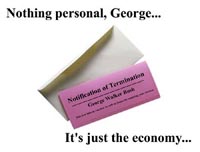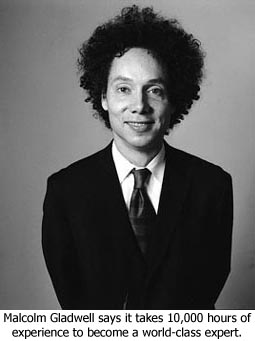
Vol. IX, No. 3, April 2009
Pink slips create entrepreneurs; beware of the roadkill traps
The current recession and high unemployment figures are likely to result in a new hatch of fledgling entrepreneurs. If you dream of developing or managing an LBE, read on to find out how to avoid five major roadkill traps that could doom your business.
 It’s ugly out there in the recession with so many unemployed. However, just like in past recessions, new business entrepreneurs will rise from the recession’s ashes. Many laid off people will get frustrated with the job search. The unemployed, as well as some who’re still employed, will decide they no longer want their incomes dependent on others. They will take charge of their livelihoods and pursue their entrepreneurial dreams of starting and growing businesses. Vistage International, an organization of CEOs, recently surveyed its members. One-third of respondents said they had been laid off or fired before becoming a founder or CEO. SmartBrief did a similar survey of CEOs and company owners: 61% of respondents said they had been laid off or fired, and half said it was the best thing that ever happened to them. Twenty years ago, Amar Bhidé, Glaubinger professor of business at Columbia Business School, studied 100 founders of Inc. magazine’s 1989 list of the 500 fastest-growing private companies in the U.S. and found virtually all had started between 1981 and 1983, during the worst post-war recession prior to the current one.
It’s ugly out there in the recession with so many unemployed. However, just like in past recessions, new business entrepreneurs will rise from the recession’s ashes. Many laid off people will get frustrated with the job search. The unemployed, as well as some who’re still employed, will decide they no longer want their incomes dependent on others. They will take charge of their livelihoods and pursue their entrepreneurial dreams of starting and growing businesses. Vistage International, an organization of CEOs, recently surveyed its members. One-third of respondents said they had been laid off or fired before becoming a founder or CEO. SmartBrief did a similar survey of CEOs and company owners: 61% of respondents said they had been laid off or fired, and half said it was the best thing that ever happened to them. Twenty years ago, Amar Bhidé, Glaubinger professor of business at Columbia Business School, studied 100 founders of Inc. magazine’s 1989 list of the 500 fastest-growing private companies in the U.S. and found virtually all had started between 1981 and 1983, during the worst post-war recession prior to the current one.
The best time to start a business is often when everyone else believes it’s the worst time. Like during past recessions, many entrepreneurs will choose to enter the location-based entertainment (LBE) industry and start FECs, children’s entertainment, edutainment or enrichment centers, play cafés, eatertainment facilities, bowling centers or other types of LBEs. Unfortunately, many of these businesses will never open or will fail soon after they do and end up in the LBE roadkill graveyard.
Starting an LBE is fraught with landmines and challenges. Many times each year, White Hutchinson Leisure & Learning Group. is hired by owners of poorly performing LBEs to identify and analyze their root cause problems and develop turnaround strategies for those businesses. Unfortunately, in some cases the prognosis is terminal. That’s because the poor performance is due to incurable major mistakes made before the center even opened. In other situations, the owners waited too long to call in experts and have depleted all their working capital. So even if their problems are solvable, they don’t have the financial wherewithal to make necessary changes.
Here’s a summary of the some of the major traps we have seen entrepreneurs fall into based on our 20 years of experience in the LBE industry. Entrepreneurs planning to enter the industry take heed!
You are NOT your customer
This is one of the mistakes we see most consistently. LBE developers make decisions about all aspects of their projects based upon their personal perspective and preferences. Rarely are the business developer’s preferences and perspective identical to those of the customers they will serve. To be successful, you need to see through your customers’ eyes and think in their brains, not your own. Below are various elements of the ‘You are NOT your customer’ trap that LBE developers become victims to.
Androcentrism
 This is the most common version of “You are NOT your customer.” With rare exceptions, women make the decisions about which LBEs their families will visit and when they’ll go. And even for non-family adult-only venues, women still rule the decision-making. Women make more than 80% of all purchase decisions and often have veto power over the decisions they don’t make. Men are from Mars, women are from Venus, and when it comes to kids, their story is from a completely different planet. Women think differently than men. Their brains are wired differently. They see, feel and experience the world differently than men do. They have different wants, needs, desires and preferences. Likewise, children’s wants, needs and desires are completely different than those of adults.
This is the most common version of “You are NOT your customer.” With rare exceptions, women make the decisions about which LBEs their families will visit and when they’ll go. And even for non-family adult-only venues, women still rule the decision-making. Women make more than 80% of all purchase decisions and often have veto power over the decisions they don’t make. Men are from Mars, women are from Venus, and when it comes to kids, their story is from a completely different planet. Women think differently than men. Their brains are wired differently. They see, feel and experience the world differently than men do. They have different wants, needs, desires and preferences. Likewise, children’s wants, needs and desires are completely different than those of adults.
Most LBEs are developed by men, designed by men and managed by men. This introduces a major gender bias in the LBE’s entire design and management, known as androcentrism. You can also call it male centeredness. Whatever you call it, it typically results in a significant mismatch between all aspects of the LBE and its core customers: women and children.
Cohortism
We all know how different Generation Y (Millennials) is from older generations. Well, there are also differences between Generation X and Baby Boomers. Too often, the LBE entrepreneur is from an age cohort different than the LBE’s target market or a large majority of the target market. This cohort bias creates a mismatch: decisions about design, management and marketing of the LBE are made from a far different generational perspective than is held by their customers.
Cultural faux pas
Less prevalent a problem in the U.S., but one we see all too frequently in our international work is the attempt to transport a Western model to another culture without making appropriate adjustments for a good cultural fit. (There are also cultural differences to take into account in different areas of the U.S.) We’ve all heard about Disney’s cultural faux pas when Disneyland Resort Paris opened — no wine being one. And that move was still within a Western culture. Move a Western model into Middle Eastern, African or Asian cultures and there are even more challenges.
Classism
 Birds of a feather flock together. That is a polite way of saying people like to hang out with people like themselves, and whether they want to admit it or not, are class conscious. This is just as true in America as in nearly every culture in the world. There is a big difference between customers who frequent Denny’s restaurants and those who’re members of country clubs, just as there is a big difference between people who shop at Nordstrom versus Walmart.
Birds of a feather flock together. That is a polite way of saying people like to hang out with people like themselves, and whether they want to admit it or not, are class conscious. This is just as true in America as in nearly every culture in the world. There is a big difference between customers who frequent Denny’s restaurants and those who’re members of country clubs, just as there is a big difference between people who shop at Nordstrom versus Walmart.
To be successful, LBEs (particular indoor venues) need to target a group of guests with a specific socioeconomic lifestyle. If the developer isn’t from the same group, there easily can be a mismatch between the LBE’s design, finishes, level of service and management and the preferences of the customers it’s trying to attract.
Be aware of your own incompetence
Real knowledge is to know the extent of one’s ignorance.
Confucius
This wisdom is 26 centuries old. In the June 2003 issue of Current Directions in Psychological Science, researchers from Cornell University and the University of Illinois at Urbana-Champaign stated, “People tend to be blissfully unaware of their incompetence. This lack of awareness arises because poor performers are doubly cursed: Their lack of skill deprives them not only of the ability to produce correct responses, but also the expertise necessary to surmise that they are not producing them. . . People are unaware of their incompetence, innocent of their ignorance.”
This double curse of not having the skills needed to produce the correct judgments, which are the very same skills needed to evaluate the accuracy of one’s responses, is one of the most difficult for entrepreneurs to overcome. An example of how this affects LBEs: The skills needed to develop the mix and layout of a center are the exact same skills necessary to recognize whether the mix and layout is correct.
Put simply, people incompetent in any area of knowledge are likewise ignorant of their incompetence. Ignorance may be bliss, but when it comes to developing an LBE, this bliss more often than not will produce roadkill.
Many things are counterintuitive
Amazingly, or maybe not so amazingly if you consider human nature, developers of LBEs continue to make many classic mistakes, so we see history continue to repeat itself. Most of these mistakes have resulted from practices that appear logical on the surface. However, the correct approach with LBEs is often just the opposite of what intuition tells someone just entering the industry. In a sense, this is a variation of “Be aware of your own incompetence.” One intuitive mistake we repeatedly see is “you’ve got to have something for everyone.” The correct counterintuitive approach is just the opposite; it’s call focused assortment—you focus on one well defined market niche and then develop a mix that appeals to them.
The emotional trap of ‘fun’
We also call this the emotional feasibility study. Many novice LBE developers have their decision-making ability clouded because they get so emotionally caught up in the “fun” of an LBE. It’s going to be so much fun that they just know it will be successful! They lose sight of the other factors and the hundreds of aspects of the business that must be executed correctly for it to succeed.
Ego and self-serving and collective bias
It takes entrepreneurial spirit to develop a major project such as an LBE. One essential component of a successful entrepreneur is ego, that strong sense of self. However, ego is a double-edged sword. Too much ego becomes hubris or arrogance, which is the sure path to irrational business decisions and failure. Too little ego, and the confidence isn’t sufficient to take on the project risk in the first place or to continue to pursue it through setbacks. Ego can be a success driver or a project killer, or both. The successful entrepreneur is one who has the ability to take intelligent risks by benefiting from their ego’s strengths while mitigating its weaknesses.
The nature of the ego can cause an entrepreneur to fall victim to a number of biases. One is known as confirmation bias or self-serving bias. When you make a decision, it may be tentative at first, but soon you’ll come up with reasons confirming your brilliant move, and you’ll ignore all factors that suggest otherwise.
Psychological research shows our desires and emotions have powerful influence on how we interpret information, even when we believe we are trying our darnedest to be objective and impartial. We are motivated to confirm the decision we have already made. Without being aware we’re doing it, we critically scrutinize and then discount facts that are contrary to the conclusions we want to reach or confirm. By the same token, we uncritically embrace evidence that supports our conclusions. Being unaware of our skewed information processing, we conclude our judgments are free from bias.
With self-serving bias, people reach conclusions that favor their own interests. In other words, self-serving bias distorts how we interpret information.
Entrepreneurs’ egos also can lead to collective bias, which can manifest itself in two ways:
- An ego-driven developer may hire “yes” people and “yes” consultants. The developer surrounds himself with people who confirm his decisions, rather than with critical thinkers who are not afraid to voice their opinions.
- The entrepreneurs’ enthusiasm and often charisma become contagious and create a collective belief that pervades the entire development team. Everyone gets caught up in wanting the project to succeed and believing it will succeed, which creates a shared collective self-serving bias with the whole group.
The bottom line of either scenario is that everyone on the project team, whether consultants or company insiders, is rooting for something they believe in. This unconsciously blinds them to the critical judgment skills that are really needed.
Research by Drew Weston, a professor of psychology at Emory University bears out people will ignore facts that contradict what they want to believe. His research shows that most of the time, people make decisions based upon bias, not fact. In the scenarios used in his study, the strength or weakness of the evidence turned out to be immaterial about 80% of the time. In other words, we believe what we want, facts be damned.
Selection bias
In an attempt to claim a winning formula for an LBE, many entrepreneurs go out and look at an existing center and copy it. We sometimes refer to these entrepreneurs as wannabes. On the surface, their plan seems totally logical. Unfortunately, copying what appear to be successful LBEs can be misleading and dangerous – and become a direct route to failure.
The statistical community frequently cites an anecdote to illustrate selection bias. World War II statistician Abraham Wald was studying the vulnerability of airplanes to enemy fire. All the data showed that certain parts of planes were hit much more often by enemy fire than other parts. So military personnel concluded that reinforcing those parts would increase the planes’ survival rate. Seems logical, doesn’t it? Well, Wald came to just the opposite conclusion: the parts hit least often should be protected more.
Wald came to this conclusion because of his understanding of the selection bias inherent in the data. The data was from only the planes that returned. It didn't include any data from the planes that were shot down. Wald reasoned that a plane would be less likely to return if it were hit in a critical area. Therefore, the ones that returned, even when hit, had not been hit in a critical location. Wald argued that reinforcing parts of returning planes that had the most hits would be unlikely to have any benefit.
Selection bias results from looking only at existing and supposedly successful LBEs, not the entire universe, which includes LBEs that failed. Anyone who tries to reach conclusions about what the winning formula is for a business by studying existing companies falls into this statistical trap. If LBE developers study only successful centers, any relationship they infer between their design, mix and management and their success will be misleading and quite possibly wrong. Rather than copying a formula for success, they may very well be copying the formula for failure. In addition to the problem of selection bias, there can be many factors that contribute to the success of existing centers that will not be present in the developer’s center. One simple example is cost. An older center cost less to build than one built at today’s prices, so what is profitable for the older LBE might not be profitable for a new center. Maybe the center failed originally and was bought by the existing owner for cents on the dollar. Maybe the existing center, although operating, is not generating enough profit to justify its replication elsewhere. (See the article below, Remember When by Frank Price, that discusses a current LBE copycat phenomenon.)
Optimism bias
Put simply, this is the tendency for people to be over-optimistic about the outcome of their planned actions. This may include overestimating the likelihood of positive outcomes and under-estimating the likelihood of negative events.
In the planning of LBEs, we often see entrepreneurs overestimate their revenues and underestimate both costs and operating expenses. We often refer to this phenomenon as seducing yourself with the pro forma.
Is there any hope?
Considering the flawed nature of the human cognitive condition when it comes to entrepreneurs starting businesses, can LBE entrepreneurs have a better success rate and can industry roadkill be prevented? Perhaps not entirely. Blind ambition will continue to drive many entrepreneurial ventures.
 Hopefully, though, many fledgling entrepreneurs will recognize the fragility of their human condition when it comes to decision-making and will turn to experienced LBE industry consultants, designers and producers to guide them through the minefields of developing a successful entertainment venue. Malcolm Gladwell’s new book, Outliers: The Story of Success, says it takes 10,000 hours, approximately 10 years, to be a world-class expert in virtually anything. Entrepreneurs starting an LBE need to seriously consider their lack of expertise when it comes to Gladwell’s 10,000-hour rule and team up with veteran industry experts.
Hopefully, though, many fledgling entrepreneurs will recognize the fragility of their human condition when it comes to decision-making and will turn to experienced LBE industry consultants, designers and producers to guide them through the minefields of developing a successful entertainment venue. Malcolm Gladwell’s new book, Outliers: The Story of Success, says it takes 10,000 hours, approximately 10 years, to be a world-class expert in virtually anything. Entrepreneurs starting an LBE need to seriously consider their lack of expertise when it comes to Gladwell’s 10,000-hour rule and team up with veteran industry experts.
Entrepreneurs working on LBE business development frequently approach our company to ask what our fees are. When we tell them, their response is often, “It’s not in my budget,” or “I can’t afford it.” Well, you get what you pay for. This may sound self-serving, but it’s really directed at trying to prevent industry roadkill. The failure of any LBE hurts the industry’s reputation and the ability of future entrepreneurs to lease store spaces and access capital. Entrepreneurs who say they can’t afford expert guidance are usually the ones who most need to save themselves from the blissful ignorance of not recognizing just how much help they really need. Successful entrepreneurs have an understanding of how their inherent sense of self, ego and cognitive biases affect their decisions.
Entrepreneurs that don’t meet the 10,000-hour rule have a very low probability of success unless they marry themselves with a company or expert who does. That rented experience can make all the difference between success and failure. It’s the difference between starting a business at the top of the learning curve versus starting at the bottom. The expert should not be a “yes” consultant or designer. Yes consultants will constantly agree with their clients to keep them happy in order to be assured of getting more business. This practice only supports collective bias. A good consultant has no hesitation in letting clients know when they are going down the wrong road, even if it creates the risk of not getting future work from the client.
Our 20-year-old company is one of a number of LBE industry consultants, designers and producers. We are not a perfect match for everyone. If you are an aspiring LBE entrepreneur, search out industry experts, put adequate money in your budget and hire the best you can find to assure your project becomes a 10-year+ successful LBE that joins the ranks of industry evergreens.
Also, anyone planning on pursuing entrepreneurial dreams should read the February 23, 2009, Wall Street Journal article, So, You Want to Be an Entrepreneur and seriously consider attending Foundations Entertainment University (see next story).


